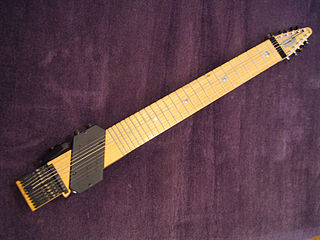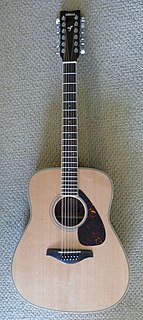
The bass guitar is a stringed instrument similar in appearance and construction to an electric guitar, except with a longer neck and scale length, and four to six strings or courses.

An electric guitar is a guitar that uses one or more pickups to convert the vibration of its strings into electrical signals. The vibration occurs when a guitar player strums, plucks, fingerpicks, slaps or taps the strings. The pickup generally uses electromagnetic induction to create this signal, which being relatively weak is fed into a guitar amplifier before being sent to the speaker(s), which converts it into audible sound.

The guitar is a fretted musical instrument that usually has six strings. It is typically played with both hands by strumming or plucking the strings with either a guitar pick or the finger(s)/fingernails of one hand, while simultaneously fretting with the fingers of the other hand. The sound of the vibrating strings is projected either acoustically, by means of the hollow chamber of the guitar, or through an electrical amplifier and a speaker.
Ibanez is a Japanese guitar brand owned by Hoshino Gakki. Based in Nagoya, Aichi, Japan, Hoshino Gakki were one of the first Japanese musical instrument companies to gain a significant foothold in import guitar sales in the United States and Europe, as well as the first brand of guitars to mass-produce the seven-string guitar and eight-string guitar. Ibanez manufactures effects, accessories, amps, and instruments in Japan, China, Indonesia and in the United States. As of 2017 they marketed nearly 165 models of bass guitar, 130 acoustic guitars, and more than 300 electric guitars.

Rickenbacker International Corporation is an electric string instrument manufacturer based in Santa Ana, California. The company is credited as the first known maker of electric guitars—in 1932—and eventually produced a range of electric guitars and bass guitars. Known for their distinctive jangle and chime, Rickenbacker twelve string guitars were favored by the Beatles and Gerry Marsden of Gerry and the Pacemakers. Well known players of the six string include John Fogerty of Creedence Clearwater Revival.

The Chapman Stick is an electric musical instrument devised by Emmett Chapman in the early 1970s. A member of the guitar family, the Chapman Stick usually has ten or twelve individually tuned strings and has been used on music recordings to play bass lines, melody lines, chords, or textures. Designed as a fully polyphonic chordal instrument, it can also cover several of these musical parts simultaneously.

The 12-string guitar is a steel-string guitar with 12 strings in six courses, which produces a richer, more ringing tone than a standard six-string guitar. Typically, the strings of the lower four courses are tuned in octaves, with those of the upper two courses tuned in unisons. The gap between the strings within each dual-string course is narrow, and the strings of each course are fretted and plucked as a single unit. The neck is wider, to accommodate the extra strings, and is similar to the width of a classical guitar neck. The sound, particularly on acoustical instruments, is fuller and more harmonically resonant than six-string instruments.

The Gibson ES-335 is the world's first commercial thinline archtop semi-acoustic electric guitar. Released by the Gibson Guitar Corporation as part of its ES series in 1958, it is neither fully hollow nor fully solid; instead, a solid maple wood block runs through the center of its body. The side "wings" formed by the two "cutaways" into its upper bouts are hollow, and the top has two violin-style f-holes over the hollow chambers.
The Fender Jaguar is an electric guitar by Fender Musical Instruments characterized by an offset-waist body, a relatively unusual switching system with two separate circuits for lead and rhythm, and a medium-scale 24" neck. Owing some roots to the Jazzmaster, it was introduced in 1962 as Fender's feature-laden top-of-the-line model, designed to lure players from Gibson. During its initial 13-year production run, the Jaguar did not sell as well as the less expensive Stratocaster and Telecaster, and achieved its most noticeable popularity in the surf music scene. After the Jaguar was taken out of production in 1975, vintage Jaguars became popular first with American punk rock players, and then more so during the alternative rock, shoegazing and indie rock movements of the 1980s and 1990s. Fender began making a version in Japan in the mid-1980s, and then introduced a USA-made reissue in 1999. Since then, Fender has made a variety of Jaguars in America, Mexico, and China under both the Fender and Squier labels. Original vintage Jaguars sell for many times their original price.

A pickup is a transducer that captures or senses mechanical vibrations produced by musical instruments, particularly stringed instruments such as the electric guitar, and converts these to an electrical signal that is amplified using an instrument amplifier to produce musical sounds through a loudspeaker in a speaker enclosure. The signal from a pickup can also be recorded directly.

Mosrite is an American guitar manufacturing company, based in Bakersfield, California, from the late 1950s to the early 1990s. Founded by Semie Moseley, Mosrite guitars were played by many rock and roll and country artists.

The Fender Mustang is a solid body electric guitar produced by the Fender Musical Instruments Corporation. It was introduced in 1964 as the basis of a major redesign of Fender's student models, the Musicmaster and Duo-Sonic. It was produced until 1982 and reissued in 1990.
The Fender Stringmaster is a series of console steel guitars produced by Fender from 1953 to 1980.

The Rickenbacker 330 is part of Rickenbacker's 300 series of guitars, the series for which Rickenbacker is perhaps best known. The 330 entered the Rickenbacker product line in 1958, though at the time the 300 series of guitars was known as the "Capri" series. It was designed by the German luthier Roger Rossmeisl. The guitar is associated by many players with the jangle-rock sounds of bands from the 1960s and 1980s. The instrument incorporates many features standard on Rickenbacker guitars, including a three-ply maple/walnut neck, a shallow headstock angle, and a thick rosewood fretboard finished with clear conversion varnish. The 330 also features a body with Rickenbacker's "crescent moon" double-cutaway shape with sharp, unbound edges, and an "R"-shaped trapeze tailpiece. One idiosyncrasy of the guitar is its dual truss rods, which allow for the correction of problematic and unwanted twists, as well as curvature, of the guitar's neck. The 330 is equipped with a monaural jack plate, lacking the Rick-O-Sound stereo functionality of other Rickenbacker models such as the Rickenbacker 360.

The Rickenbacker 360 is an electric, semi-acoustic guitar made by Rickenbacker, and part of the Rickenbacker 300 Series. The instrument incorporates many features standard on Rickenbacker guitars, including a three-ply maple/walnut neck, shallow headstock angle, a thick rosewood fretboard finished with clear conversion varnish, and double truss rods. The 360 also features stereo or mono output, a body with Rickenbacker's "crescent moon" cutaway shape and rounded top edge and bound back, and an "R"-shaped trapeze tailpiece. A twelve-string version of the 360 is available. A three-pickup version of this model is also available, the 370.

The Rickenbacker 620 is a solid-body guitar manufactured by the Rickenbacker International Corporation (RIC). It is part of the 600 series of guitars which all share the distinctive "cresting wave" styled body. The Rickenbacker 620 features triangular fret markers, a thick rosewood fret board, a maple body with neck-thru construction, and maple neck. The 620 also comes standard with a stereo output jack. The guitar's pickups are twin single coil 'Hi-gains'. The Rickenbacker 620 sports the Rickenbacker signature, an 'R' style floating tailpiece. There is a twelve string version of this guitar available, the Rickenbacker 620/12. The Rickenbacker 620 comes in fireglo, mapleglo, jetglo, and midnight blue finishes from the factory. The 620 is less popular with big recording artists as its siblings the 330 and 360, however some guitarists have consistently used them including Christopher Owens of Girls, Chris Urbanowicz of Editors. Mike Campbell of Tom Petty and the Heartbreakers acquired the first 620/12 12-string in 1977, and has used it on hits such as Listen to Her Heart and Here Comes My Girl.
The Megatar is a stringed musical instrument designed to be played with two-handed tapping. It is manufactured by the U.S. company 'Mobius Megatar'.

The Parker Fly is a type of electric guitar built by Parker Guitars. It was designed by Ken Parker and Larry Fishman, and first produced in 1993. The Fly is unique among electric guitars in the way it uses composite materials. It is notable for its light weight and resonance. It was also one of the first electric guitars to combine traditional magnetic pickups with piezoelectric pickups, allowing the guitarist to access both acoustic and electric tones.
The Vox Custom 24 was one of a group of guitars produced in Japan by the Matsumoku company between 1980–85, which included the Custom and Standard 24 and Custom and Standard 25 guitars. There were also Custom and Standard bass guitars in the range.
















